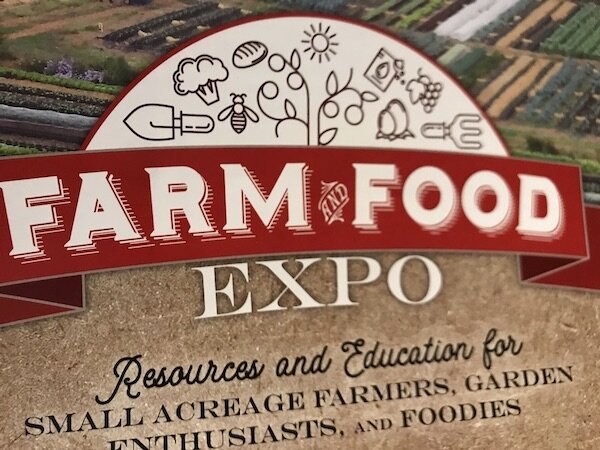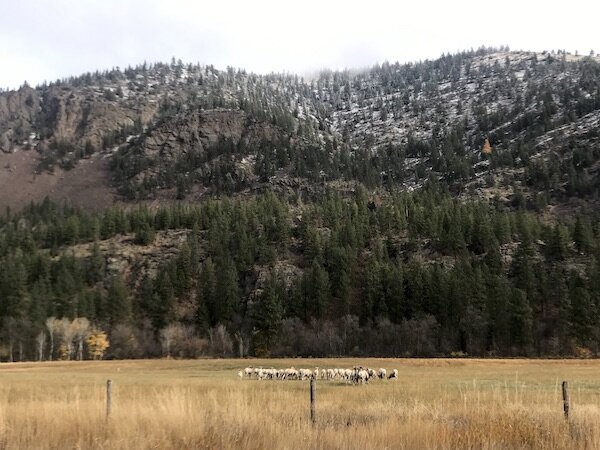2019 Spokane Farm and Food Expo
One of my friends says I should just get a PO box in Spokane because I spend so much time there. It certainly is starting to feel like it, and I don’t even have a child in college there anymore. This was my sixth trip to/through Spokane in the last two months and the one that was the most fun:
I’ve been trying for three years to get to the Spokane Farm and Food Expo. The keynote and classes always seemed to sell out before I could register. Two years ago, the speaker was Curtis Stone, an urban farmer in Vancouver, BC. The husband likes his YouTube videos. Last year, the speaker was Joel Salatin, and registration sold out almost immediately. This year, I set my alarm for the opening day of registration. I got in! And when I found out that the speakers were Elizabeth and Paul Kaiser, of Singing Frogs Farm in Sebastapol, CA, I was even more excited. They are frequent guests on several podcasts I listen to and focus on soil health and soil biology and specifically no-till organic farming.
Our neighbor, Elysian, was also able to register, so we made plans to attend together. Her little guy stayed in Kalispell with friends, and she and I headed out late Thursday afternoon. I don’t usually drive to Spokane so late in the day, but we were rewarded with a spectacular sunset as we came over the top of Lookout Pass.
The conference started Friday morning with a presentation by Paul and Elizabeth about their farm. They live on eight acres, three of which are devoted to vegetable production. They gross $100,000 per acre annually. Fifty percent of what they grow is sold as part of their year-round CSA, 45% at two year-round farmers markets and one seasonal one, and the rest goes to a few select restaurants in the Bay area. They tilled the ground the first year they were on the property (2007) and decided there had to be a better way. By switching to a no-till model, they have increased the organic matter in their soil by 400% and routinely get 3-8 crops per bed per season. The key is to cut the current crop when it is ready to harvest but leave the roots of those plants in the soil, undisturbed. The remainder goes into compost beds, and the new crop is transplanted right around the roots of the previous crop. They do very little direct seeding.
[I need to note here that even though the Expo is aimed at providing “resources and education for small acreage farmers, garden enthusiasts, and foodies,” it quickly became apparent to Elysian and me that the bulk of the event was aimed at people with market gardens. We spoke to a lot of people who run CSAs (community-supported agriculture) and/or sell at farmer’s markets, and while we found this whole experience extremely valuable and plan to attend next year, too, we will have to be creative in how we apply some of what we learned. Here in Montana, we are not going to be getting much more than one crop per bed per season.]
After lunch, Elysian and I split up to attend 50-minute seminars on various topics. We found out when we arrived that we weren’t required to attend the seminars we had registered for, so Elysian switched up some of her choices. I stuck with my original slate. My first seminar was on mushroom propagation, and it was really the only clunker of the whole Expo. The seminar presenters appear to be drawn from a pool of local people or friends of the organizers. This presenter was a guy in his late 20s or early 30s. I try not to judge people on appearances, but if you are going to work hard to project a certain image, you should not be surprised when my prejudices are proven accurate. This guy was scruffy-looking, with dreadlocks stuffed up into a Rastafarian-style hat. I suspect his interest in mushrooms isn’t necessarily for culinary reasons. His presentation was rambling and unfocused and about the only information I got on how to propagate mushrooms was to put them in a five-gallon bucket with water and let them sit for a few days, then dump the water out in a bed or in the woods and hope that some mushrooms come up. I may try this next spring, but I doubt I am going to devote a lot of energy to it. I don’t need another hobby.
The next seminar was on reducing plastic use and waste. The presenter was a dynamic woman about my age and she had a lot of good information to share. She asked us to name our biggest plastic challenge. Mine is yogurt. I want to make yogurt in my Instant Pot so I don’t have to buy small containers, but then I have to buy half-gallon plastic milk containers to make the yogurt. So much for reducing plastic waste. I’ve gone back to buying yogurt because at least I can give the containers to Anna to use for her catering leftovers. I had a much harder time repurposing half-gallon milk containers. (Kalispell Kreamery was looking into using glass containers instead of plastic, but that hasn’t been as easy as we all hoped it would be.)
The last seminar of the day was on cooking with lavender. For the past several months, I have been hearing a distinction made between “oil lavender” and “culinary lavender” and I could not for the life of me figure out what people were talking about. It finally dawned on me, minutes into this presentation, that people are now making a distinction between true lavender and lavandin. True lavender is English lavender, or Lavandula angustifolia. Lavandin is a cross between true lavender and Lavandula latifolia, or spike lavender, which is native to the Mediterranean. Lavandin has a much stronger scent profile with turpentine and camphor undertones—not necessarily flavors you would want in your food. Once I figured that out, this all made more sense. I’m not sure I like the new terminology, but whatever. The seminar was very informative on a lot of levels and included samples of shortbread, simple syrup, and lavender-infused honey (yum). I have a ton of lavender, but I no longer know which variety is which and they have interbred promiscuously. I would have to test mine to make sure I was cooking with a true lavender and not a lavandin.
The Expo also featured quite a few vendors of various farm-related items. Elysian had never had bacon jam, so when I saw that someone was selling it, I bought her a jar. Bacon jam is awesome:
I had another seminar with Paul and Elizabeth Kaiser on Saturday morning. They provided more specifics on increasing soil health and productivity. It’s nice to know that we already are incorporating many of their suggestions—we are trying not to till anymore and leaving as much organic material in the garden over the winter as we can—but I have a list of ideas to try next year. I want to intersperse more plantings of flowers and move some of the herbs over to the big garden. They have herbs and flowers as “end caps” on most of their rows and I think that’s a great idea. I was also happy to hear that they don’t have a problem with using tarps and black plastic for weed control. I haven’t noticed a problem with it in our garden and indeed, it gives the snakes a place to hang out in the heat of the day.
My first Saturday seminar was one of the highlights of the Expo. The topic was “Organic Pest Management for Orchards.” The presenter and her husband purchased an old homestead in Athol, Idaho, which is about halfway between Coeur d’Alene and Sandpoint. There had been an apple orchard on the homestead, but all but four of the original trees were gone. They replanted with 100 new trees, all of which were heirloom varieties like Seek-No-Further, Duchess of Oldenburg, and Nero, but had to eradicate voles, codling moths, and other pests in order to make their orchard commercially viable. (She also noted that two of their original trees were Red Delicious, but they are the Red Delicious before it was Frankensteined into the awful apple it is today.) We had absolutely zero pest damage on our apples this year. I am wondering if that is a fluke and I’m lucky, or if we have exceptionally healthy trees. I didn’t even spray with dormant oil. But if we ever get a pest infestation, now I know what works and what doesn’t.
The second seminar was an introduction to aquaponics. I hope this presenter comes back next year because he was excellent. I had to laugh, though, when he was talking about suitable fish for aquaponics systems; apparently, the state of Idaho has declared yellow perch an invasive species and wants them out. They are a delicacy where I grew up, on Lake Erie. This seminar also had me rethinking whether or not to set up an aquaponics system in the garage after the husband moves over to the new shop. I would love to have lettuce 365 days a year, but is it worth the extra effort? Still thinking on that.
The last seminar was a “make and take” on herbal skin care products. We made two kinds of bath salts. (I gave one of mine to Elysian because I prefer showers to baths.) That was the perfect end to the Expo.
It was late enough on Saturday that we stayed one more night in Spokane before heading home yesterday morning. As we were coming through the Paradise Valley in Montana, I spotted this:
We pulled over so Elysian could take pictures on our phones. I’ve seen individual bighorn sheep in this area many times, but never a whole flock of them. The males are impressive with their big curling horns:
Hopefully, I will be staying put for a while. I’ve got lots of work to do this week. And it snowed overnight—about two inches so far. Winter has arrived.




